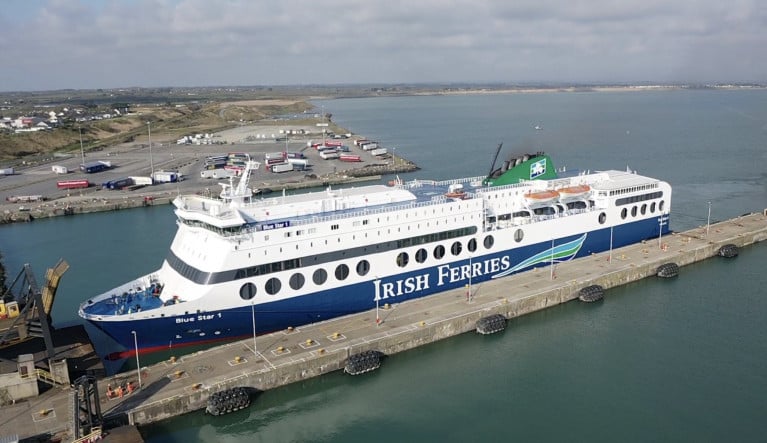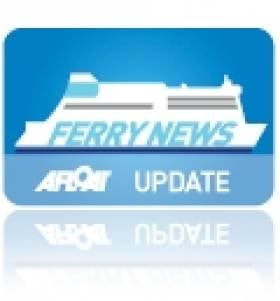Displaying items by tag: RosslarePembroke
Irish Ferries celebrated the first day of sailings today of the cruiseferry Oscar Wilde, which is the largest and fastest on the Irish Sea and aims to live up to the famous Oscar Wilde quote “I have the simplest of tastes. I am always satisfied with the best”.
The chartered cruiseferry which was built in Finland, likewise of Ulysses (but at different shipyard), has an impressive capacity of 2,080 passengers, 134 well-appointed cabins, and ample space with over 2,380 lane meters for cars, coaches, and freight vehicles.
Oscar Wilde replaced the Blue Star 1 on the Ireland-Wales route with service starting just in time for the peak summer season (see yesterday's Afloat coverage) of Oscar Wilde which last night took over operating the Rosslare-Pembroke route. The newcomer operates twice-daily sailings, offering an elevated experience connecting Ireland to the UK.
Irish customers can sail directly to Wales, a place of natural drama, with beautiful beaches and mountain walks, rich history, and culture to explore, as well as epic national parks and other adventures, perfect for either short getaways or longer breaks. The route is also a gateway to the rest of Britain with the car – Windsor and Legoland can be reached in under 4 hours - thus avoiding security queues, luggage limits, cramped journeys, and excessive car hire costs.
The Oscar Wilde interiors have a classic, modern feel, while the exterior showcases Irish Ferries’ signature colours and branding.
There are facilities for all with comfortable cabins, a Club Class lounge, plenty of choices for food and beverages including a self-service restaurant, a café, a bar, and a freight drivers lounge.
Passengers can enjoy sea views and fresh air on the open decks, and there are also pet facilities, family-friendly features such as a children's play area, and an extensive shopping space, perfect for using the generous post Brexit duty-free allowances.
With a possible top speed of 27.5 knots, Oscar Wilde is the fastest cruise ferry on the Irish Sea, enabling Irish Ferries to provide tourism and freight customers an efficient and reliable service, getting them to their destination quickly and comfortably.
On the latest addition to Irish Ferries’ fleet, Irish Ferries Managing Director, Andrew Sheen, said, "We are delighted that Oscar Wilde is officially in service, offering customers an enhanced Irish Sea journey on board a ship featuring the very best in terms of comfort, speed, and amenities. We are confident that the Oscar Wilde will become a firm favourite with our passengers and freight customers, and we look forward to welcoming them on board."
Irish Ferries encourages travellers to “Sea Travel Differently” – whether for holidays, business trips, reuniting with loved ones, or planning a road-trip to remember. With award-winning hospitality and service, onboard duty-free shopping, and extensive amenities to make the journey even more special, as well as the ability to take as much luggage as they can fit, bring along their pets, and travel in the comfort of their own car – the holiday really does begin once guests step onboard.
Personnel Express Concern for Future of Irish Ferries’ Rosslare-Pembroke Dock Route
Personnel working for Irish Ferries Rosslare-Pembroke Dock route have expressed growing concerns as rumours circulate that the company is to pull out of the Wexford ferryport and abandon the Ireland-Wales service.
The ferry division of the Irish Continental Group (ICG) has remained tight-lipped on its plans and despite queries, the Irish Ferries media contact and a senior company official in Rosslare Europort, has given no response at the time of Wexford People's publication of the story.
Among the mounting concerns arises from customers that are unable to book a passage (on the 4 hour 30 minute route) beyond the 31st May this year. The timeline of the booking schedule could potentially relate to the expiry date of Irish Ferries charter of the Greek flagged ferry Blue Star 1 from the Attica Group, having entered service in 2021. The Athens based group operates brands, among them Superfast (see related ferry series story).
The 1,500 passenger Blue Star 1 with a 700 car capacity (depending on freight volumes) and 100 trucks, has faced several issues for Irish Ferries, as the ropax was detained by the Maritime and Coastguard Agency (MCA).
The 29,858 gross tonnage ropax was detained as recently as of December due to failing a safety inspection carried out by the UK agency.
More on the story here concerning the future role of the Irish Sea serving Blue Star 1 which was built by the Van der Giessen de Noord shipyard in 2000.
This is the same Dutch shipyard that ICG placed an order for the cruiseferry Isle of Inishmore which entered service in 1997. The charter of Blue Star 1 led to the cruiseferry transferred to Irish Ferries new service on the Dover-Calais route in 2021.
Originally the Irish state-owned ferry company, the B+I Line opened the route in 1980 competing with rivals, Sealink/ British Rail whose current successor Stena Line operates the Rosslare-Fishguard route.
Last year, Stena Line denied rumours to close the St. Georges Channel route which has a slightly shorter passage time of 3 hours 30 minutes.
Rosslare-Pembroke Dock Route Currently Suspended
Irish Ferries Rosslare -Pembroke Dock ferry route is currently suspended.
On the operator's sailing updates webpage, the Ireland-Wales route has a warning update.
It reads: "Irish Ferries regrets to advise that the 8.45 Rosslare to Pembroke Blue Star 1 sailing on May 3 has now been cancelled due to ship disruption. You can be accommodated on the Stena Line sailing to Fishguard instead."
The warning is in place on all dates up to May 5 going both ways.
The 'NI Ferry Site blog' reported the Pembroke Dock to Rosslare route was currently not running. The site, which gives updates on the shipping industry, said the reason was that Blue Star 1, the ferry that services the Pembroke Dock to Rosslare route, has been moved to Dublin while W.B Yeats, which serves the Dublin to Cherbourg route, receives maintenance.
NI Ferry Site blog said: "In order to release W.B. Yeats to have a new upper bow door to be fitted, Irish Ferries has moved Blue Star 1 north to take over the Dublin to Cherbourg route.
For further details of the dry-docking at H&W, Belfast, the Western Telegraph reports.
As reported only in mid-March, W.B.Yeats was also in H&W Belfast when the cruiseferry had repairs to the upper car-deck following damage in heavy seas.
Afloat will have further sailing updates on Irish Ferries fleet movements to reflect the changes on both routes.
Charter of Newer & Faster Passenger RoRo for Irish Ferries Rosslare - Pembroke Route
With Irish Ferries to launch a first ever service on a UK-France route next month, the company also announced the addition of a passenger ro-ro ferry Blue Star 1 to its Rosslare to Pembroke Dock route.
The ship (to replace Isle of Inishmore) is being chartered from the Attica Group and delivery is expected in early April 2021.
Blue Star 1 was built in 2000 by the Van der Giessen de Noord shipyard in the Netherlands, the same shipyard that in 1997 built Irish Ferries Isle of Inishmore, currently servicing the Rosslare to Pembroke Dock route.
The Blue Star 1 has the capacity to carry up to 1,500 passengers, 100 freight vehicles and up to 700 cars depending on freight volume.
The ship offers a host of quality facilities including 192 cabins for freight drivers/passengers, self-service restaurant, café/bar, Club Class lounge, onboard duty-free shop, children’s play area and spacious outdoor decks. The tripling of cabin numbers will facilitate more single occupancy cabins for freight drivers, a welcome development for our freight customers.
Andrew Sheen, Irish Ferries Managing Director, said: “We are very pleased to add a quality ship of the calibre of the versatile Blue Star 1 to the Irish Ferries fleet. This ship will be the fastest RoRo Passenger ship operating between Britain and Ireland and this will help ensure schedule integrity. The introduction of this ship underlines our commitment to the Rosslare to Pembroke route, the primary shipping corridor between Ireland and South Wales. It also underlines our commitment to the significant contribution that this route makes in facilitating trade for both exporters and importers as well as facilitating essential passenger movements and future tourists as the country re-opens post COVID-19”.
Irish Ferries Signs 10-Year Contract On Welsh Route
The St. Georges channel crossing carries over 300,000 passengers and 80,000 freight annually and is served by the 34,031grt Isle of Inishmore. The ro-pax can handle 2,200 passengers, 802 cars / 152 freight trailers and is scheduled to two daily round trips, on a route that take nearly five hours.
The 1997 Dutch built vessel was first launched onto the central corridor route between Dublin-Holyhead but was transferred to the southern service after the introduction of Ulysses in 2001.
Rosslare-Pembroke Dock sailings only began in 1980, firstly operated by the B+I Line which competed with rival operators Sealink / British Rail (now Stena Line) on services running out of Fishguard.
This route was well established having started operations in 1906 and in an era when the railway companies (in this case the Great Western Railway) developed and owned the ports plus the operation of shipping services on the Irish Sea.





























































